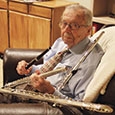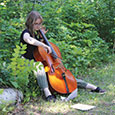This article originally appeared in the November 1974 issue of The Instrumentalist.
The sad fate of a great musician who has markedly influenced the course of performance style in his lifetime is that, unless he has also left behind a large body of writings or solo recordings, the recognition of his heritage is likely to fade too soon after his death.
Such a fate, however, is less apt to befall the cherished memory of William Kincaid, the stellar principal flutist of the Philadelphia Orchestra from 1921 to 1960, thanks to the foresight of John Krell, who kept extensive lesson notes while a student of Kincaid’s at the Curtis Institute of Music in 1939-41. Krell recently reshaped his original notes (copies of which had reached a rather wide "underground" circulation) into a short volume called Kincaidiana.
As Krell explains in his preface, the preparation of the book "involved a reexamination of the notes, which in turn suggested a complete reworking to eliminate some of the more extravagant generalizations that go with the brashness of youth and to amplify other short-hand observations incompletely described in the original. However, it must be understood that these notes are not a quoting of chapter and verse on Mr. Kincaid, but rather an attempt to explain back to myself the musical values and philosophies he inspired. As such there are subjective interpretations involved, although all of the root ideas stem directly from Kincaid’s musical intelligence and artistry."
Krell joined the Philadelphia Orchestra in 1952 as principal piccolo, renewing his association with Kinkaid — this time as a playing colleague. The subsequent eight years until Kincaid’s retirement no doubt furnished many new insights that enabled Krell to rework his earlier notes into the highly coherent and readable Kincaidiana.
Krell covers well the highlights of Kincaid’s ideas, both technical and musical, but his best contribution lies in preserving some of the recurring "themes" that were so typical of Kincaid’s teaching, particularly the fine analogies he often drew between the techniques of violin bowing and the flutist’s control of tone and articulation. The following paragraph from page 17 summarizes his rationale:
Flutists can learn a great deal about articulation from the strings, who appear to have the greatest variety and option of articulations. With the tremendous bowing potentials of the arm, wrist and fingers, the violinist has an infinitely sophisticated assortment of attacks, sustainings and releases ranging through the detachés, portiés, lourés, martelés, staccatos, spiccatos, ricochets, etc. —not to mention the subtle but significant differences between the impulses of the up and down bows. It is instructive and provocative for the flutist to explore bowing techniques in order to approximate the subtleties of violin articulation. All too frequently. the woodwind designations of tonguing are limited to the simple long, medium and short.
Kincaid was usually very reluctant to be explicit or technical in his approach to certain problems, especially embouchure conformation. As Krell remarks, "he preferred to describe the character of the tone desired, leaving it up to the student to search out the quality in terms of his own physical resources." Nevertheless, in "describing the character of the tone desired" or any other aspect of flute playing, Kincaid had a rare gift for imagery that made its point unerringly — especially so, when he would follow up with personal demonstration. Kincaidiana contains a generous sampling of these colorful similes and metaphors, but one can’t help but wonder how meaningful they really are to flutists who never had the privilege of hearing Kincaid in person. Actually it is not surprising that Kincaid (as well as so many other great artists) chose not to write about his techniques, for it is very tricky to explain artistic points in cold print without the possibility of live demonstration and the all-important feedback from the reader-student.
In any case, Krell’s distillation of many of these Kincaidisms turn out to be delightful reading. Here are a few samples:
Cautioning against any motion of the jaw or lips while tonguing: "Tongue like a ventriloquist without moving the lips."
On changing tone color and intensity by emulating the violinist’s tonal options: "The flute can produce a finger-board flautando (lots of loose air across the mouth hole) or a bristly bridge tone (pressure of tight air directed more into the flute) together with all the intermediate intensities."
On trilling: "Avoid the alarm-clock sort of reaction to the trill sign, and always relate the speed of the trill to the tempo and character of the movement . . . "
And this next one describes one of the hallmarks of the Kincaid style: "Learn to breathe out on the gentle releases (like blowing out a candle) so that the sound is tapered off, keeping the air moving even after the sound has evaporated."
Some of the analogies, if taken too literally, can be somewhat misleading, as for example this one, which tries to justify the necessity for "small exaggerations in performance in order to fill up the space between performer and audience. Dynamics and intensities are like an actor’s makeup. The same makeup which looks grotesque at close range appears natural from the vantage of the fifteenth row in the audience … "
The first part of the book covers embouchure, breathing and resonance, whistle tones, relative intensity, vibrato, tonguing and articulation, and finger technique. The second and third parts are concerned mostly with phrasing, and the appendices contain miscellaneous material about daily practice routines, the flutist’s repertoire, reference works, difference tones, and an interview with Kincaid reprinted from the May 1960 International Musician. (A short biographical sketch would have been welcome in this section.)
In considering the material on phrasing in Kincaidiana, I must admit to a certain rebelliousness against what I now feel to be an overly restrictive approach: Kincaid’s note group bracketing system (which Krell explains very well). Having studied with one of Kincaid’s most illustrious pupils (and with the master himself one summer), I was of course indoctrinated to this system, and although it has been valuable for many situations (especially in florid passage type of work), its application to other phrasing problems has proved to be less adequate. In some ways it reminds me too much of Riemann’s theory of phrase analysis,1 in which great pains are taken to "prove" that every group of notes can be explained as an upbeat pattern.
Music is too elusive an art form to allow itself to be molded into such neatly defined phrase compartments. And paradoxically, sometimes the simpler the music, the more complex its phrasing possibilities. Even a cursory study of an excellent treatise like Cooper and Meyer’s The Rhythmic Structure of Music (University of Chicago Press, 1963) will quickly open up one’s eyes and ears to the almost infinite possibilities of analyzing music’s linear structure.
Fortunately, however, we needn’t depend on the theorists, no matter how fascinatingly they explore the musical labyrinths, to teach us how to phrase. The best thing we can do is learn to listen with more sensitivity and discrimination to the performances of the great violinists, cellists, pianists and singers (as well as flutists), and not feel guilty about attempting to imitate their subtle ways of applying nuance and tonal inflection to shape their phrases. The gradual absorption of this artistic phrase feeling then becomes a more natural part of our own style.
Looking back, I believe I learned more about phrasing from listening to Kincaid’s magical performances than I did from pencilling brackets all over my music. Like a true artist, Kincaid, too, was very good at bending his own "rules."
1. See pp. 54-57 of Hermann Keller’s Phrasing and Articulation (N.Y.: W.W. Norton & Co., 1965). See also pp. 4, 20, 27-28, and 74.






